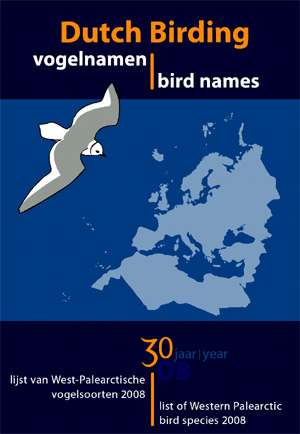Dutch Birding's Birdnames

PREFACE
The Dutch Birding Association (DBA) was founded in 1979 and, within birding circles, Dutch Birding has been a pioneer in popularizing new developments in taxonomy ever since. The first DBA Checklist by Gerald J Oreel in 1980 was a list of all bird species ever recorded in the Netherlands (see numbers 2 and 3 of Dutch Birding volume 2*). The new and completely updated Dutch Birding bird names - list of Western Palearctic bird species 2008 celebrates the 30th volume of Dutch Birding. It lists all species recorded in Western Palearctic (WP) countries, with Dutch, English and scientific names throughout, and with annotations for the Dutch list. Strictly following certain rules and new references, the list can be seen as progressive, and it is hoped that many (if not all) birders in the Netherlands, Europe and elsewhere will use it for listing purposes. It is interesting to look back and to compare this new list with its predecessor in 1980. Apart from the wider context, the increase of the number of species and the many differences in taxonomy and vernacular names are striking. But even when comparing this new list with its previous edition of just two years ago (2006), one will discover hundreds of changes as well. Perhaps without realizing it, thousands of birders and ornithologists from all over the world have contributed to this list, if only by discovering a new species for the Netherlands or the WP. It should be remembered that the list can not deliver anything other than a snapshot of current knowledge, while the choice of references may be debatable. As such, it will not be the Absolute Truth, and we may anticipate future changes. The DBA, therefore, intends to publish new editions in coming years whenever the amount of new information makes it desirable. And we cannot wait to see what the changes will be after another 30 years!
Katwijk, 20 december 2007
Gijsbert van der Bent, chairman Dutch Birding Association
*See here for the pdf-files of these issues.
INTRODUCTION
This list of Dutch, English and scientific Western Palearctic (WP) (sub)species names follows the 'rules' set by the Dutch Birding journal and the Dutch committee for avian systematics (CSNA) (see Dickinson 2003, Redactie Dutch Birding 2002-08, cf Robb et al 2008, Sangster et al 1999-07).
The list is confined to (sub)species ('taxa') occurring in the smallest variant of the Western Palearctic (WP) region, also referred to as 'greater Europe', which is defined here as Europe with Macaronesia and all countries bordering the Black, Dead or Mediterranean Sea.
This definition means that, in the south, boundaries of countries are followed and all species are listed of countries like Morocco, Algeria, Libya and Egypt but not species recorded in WP areas within countries like Mauritania or Chad. Obviously, in the Middle East, many more countries and parts of countries lie within the WP region but these are beyond the boundaries of this list. The birds of the Western Palearctic (Cramp & Simmons 1977), for instance, includes Armenia, Azerbaydzhan, Iraq, Kuwait and northernmost Saudi Arabia in the WP region. For this list, such inclusion would mean the addition of at least Socotra Cormorant Phalacrocorax nigrogularis, Forest Wagtail Dendronanthus indicus, Hume's Wheatear Oenanthe albonigra and Caspian Tit Poecile hyrcanus.
The list is simply meant to be a practical birders' tool to facilitate communication. It presents the names which were agreed upon by January 2008, with the knowledge that changes in taxonomy are to be expected in coming years. The English vernacular names are those recommended by the International Ornithological Congress (Gill & Wright 2006). The Dutch names are based upon Walters (1997).
The list includes a selection of seven species which were not accepted in any country other than in 'category D', indicating concerns about their provenance (Cape Shoveler in Morocco, Jouanin's Petrel in Italy, Chinese Pond Heron in England, Finland, Hungary and Norway, Swallow-tailed Kite in Canary Islands, Swainson's Hawk in France and Norway, Kelp Gull in France (a report in Morocco has not yet been accepted) and Mugimaki Flycatcher in England). 'Category D' is not applied by rarities committees in the Netherlands and therefore not in this list either (cf Mitchell & Young 2006).
The list also includes taxa which have gone extinct in the world since 1840 (Canary Islands Oystercatcher, Eskimo Curlew, Slender-billed Curlew, Great Auk and Lanzarote Chiffchaff).
A number of distinct subspecies are listed as well. These concern taxa which sometimes have been considered specifically distinct. When subspecies are mentioned, the commonest European taxon is not repeated when that also happens to be the nominate (with the exception of a few confusion cases).
Unnamed taxa are not listed (eg, Grey-bellied Brent Goose, Monteiro's Storm Petrel, Grant's Storm Petrel and crossbill 'vocal types' A Wandering, B Bohemian, C Glip, D Phantom, E British, F Scarce and X Parakeet Crossbill; cf Constantine & The Sound Approach 2006, Robb et al 2008).
Species for which it is certain that no single individual arrived or occurred by its own force as a wild bird anywhere in the WP are excluded. For vernacular and scientific names of escapes in the Netherlands, see Ebels (1996, 2004). Introduced species with viable breeding populations of which all individuals or their ancestors certainly originate from captivity are listed in a separate table.
How to Order
Extra copies of this special issue amount to EUR 4.50 (or the equivalent in other currencies) each (including p & p) and can be ordered as follows:
Send an e-mail to circulation@dutchbirding.nl or write a letter to:
Dutch Birding Association
c/o Gerald Oreel
Deurganck 15
1902 AN Castricum
Netherlands
indicating your Visa or Eurocard/ Mastercard number and expiry date.
Address your payment to Dutch Birding Association in Castricum / The Netherlands, indicating "Dutch Birding's names".






